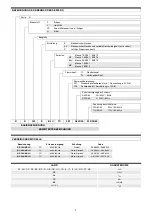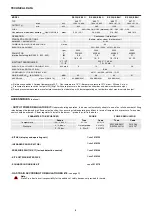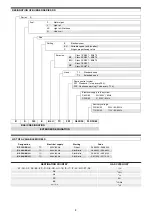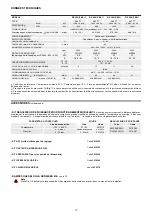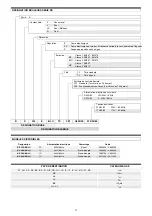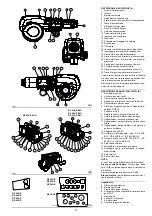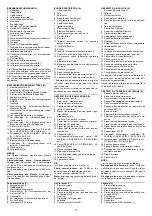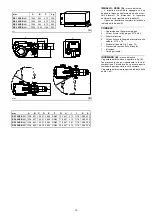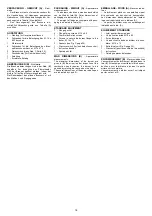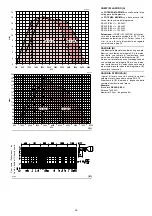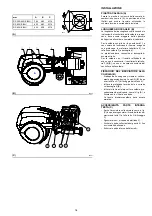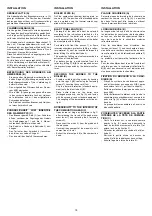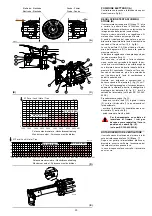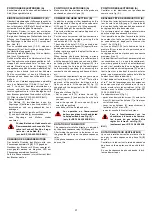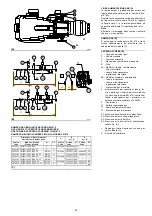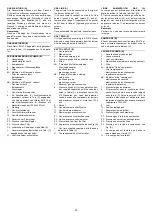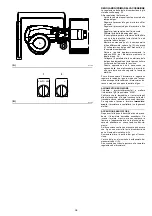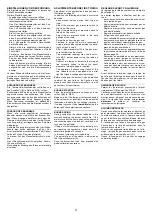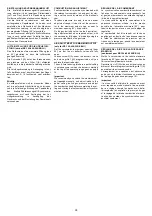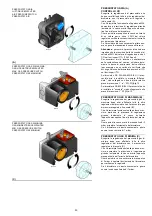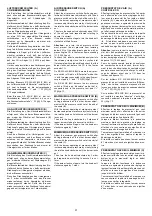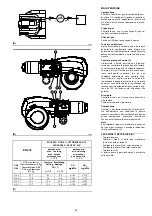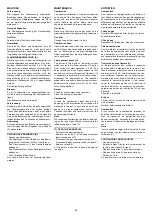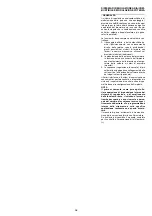
21
POSITION DER ELEKTRODEN (A)
Kontrollieren Sie, ob Sonde und Elektrode wie in
Abb. (A) ausgerichtet sind.
EINSTELLUNG DES FLAMMKOPF (B)
Über der Veränderung der Luftmenge je nach Lei-
stungsbedarf hinaus, verändert der Stellantrieb
des Luftschiebers 4)(A)Seite 12 durch ein Hebel-
system die Einstellung des Flammkopfs.
Mit diesem System ist auch bei minimalem
Regelbereich eine optimale Einstellung möglich.
Bei gleicher Drehung des Stellantriebs kann die
Öffnung des Flammkopfs durch Verschiebung
der Zugstange in die Löcher 1-2-3 variiert wer-
den, Abb. (B).
Das zu verwendende Loch (1-2-3) wird nach
Diagramm (D) auf der Grundlage der geforder-
ten Höchstleistung gewählt.
Werkseitig wird die Einstellung für den Höchst-
hub (Loch 3) vorbereitet.
Solte der Luftdurchsatz an Heizkesseln mit star-
kem Gegendruck auch bei ganz geöffneter Luft-
klappe nicht ausreichend sein, so kann eine
andere Einstellung als die im Diagramm (D)
angegebene ausgeführt werden, wobei die Zug-
stange in das nächste Loch mit der höheren
Zahl zu verschieben ist, was die Öffnung des
Flammkopfs und daher den Luftdurchsatz ver-
größert.
Sollte es aus Verbrennungsgründen notwendig
sein, das Distanzstück (1) Abb. (C) auf das 1.
und 2. Loch des Zahnrads verschieben zu
müssen und sollte das Scharnier gleichzeitig
rechts angebracht sein, ist die Montage der mit
dem Brenner gelieferten Distanzstücke (4) Abb.
(C) Pflicht (nur bei RS 300-400-500/E BLU).
Wie folgt vorgehen (Abb. C):
- Die Muttern (2) losschrauben, dann die
Zugstange (3) entfernen, das Distanzstück (1)
losschrauben und am gewünschten Loch
anbringen,
- die Distanzstücke (4) jeweils am Distanzstück
(1) und der Schraube (5) anschrauben,
- dann Zugstange und Muttern wieder
montieren.
Für den Betrieb an Heizkesseln mit
Flammenumkehr müssen die Gas-
rohre im Loch auf Position 4 regu-
liert sein – siehe Abb. (E) -
(nur bei RS 300-400-500/E BLU).
DREHUNG DES GEBLÄSEMOTORS
Der korrekte Drehsinn des Motors wird vom
Phasensequenzrelais 16)(B) S. 12 gegeben.
Nachdem der Brenner mit Strom versorgt ist,
muss geprüft werden, ob die grüne LED am
Phasensequenzrelais aufleuchtet.
Falls die Phasensequenz ist nicht korrekt, fährt
der Brenner nicht an.
POSITION OF ELECTRODES (A)
Make sure that the electrode and the probe are
positioned as shown in figure (A).
COMBUSTION HEAD SETTING (B)
In addition to varying air flow depending on the
output requested, the air gate valve servomotor
4)(A) pag. 12 - by means of a lifting assembly -
varies the setting of the combustion head.
This system allows an optimal setting even at a
minimum firing rate.
For the same servomotor rotation, combustion
head opening can be varied by moving the tie
rod onto holes 1-2-3, fig. (B).
The choice of the hole (1-2-3) to be used is de-
cided on the basis of diagram (D) against the re-
quired maximum output.
Setting is pre-arranged in the plant for the maxi-
mum run (hole 3).
When dealing with boilers featuring a strong
back pressure, if air delivery is insufficient even
with the damper fully open, you can use a differ-
ent setting to that illustrated in diagram (D) - do
this by moving the tie rod onto the next highest
hole numerically speaking, thus increasing the
combustion head’s opening and hence air deliv-
ery.
If combustion requirements require you to move
spacer (1) fig. (C) onto the 1
st
or 2
nd
hole of the
gear and, at the same time, the hinge is on the
right, you need to fit the spacers (4) fig. (C)
supplied with the burner (only for RS 300-400-
500/E BLU).
Proceed as follows (fig. C):
- first unscrew nuts (2), remove tie rod (3),
unscrew spacer (1) and position it on the hole
you want,
- screw the spacers (4) onto spacer (1) and
screw (5) respectively,
- once done, refit the tie rod and nuts.
For operation on flame-reversal
boilers, gas pipes must be adjusted
to hole position 4, see Fig. (E) -
(only for RS 300-400-500/E BLU).
ROTATION OF FAN MOTOR
The correct motor rotation direction is indicated
by the phase sequence relay 16)(B) page 12.
After turning the power on to the burner, check
the green led lights up on the phase sequence
relay.
If the phase sequence is not correct, the burner
does not fire.
POSITION DES ELECTRODES (A)
Contrôler si les électrodes sont positionnées
comme sur la fig. (A).
RÉGLAGE TÊTE DE COMBUSTION (B)
A l’aide d’un levier de transmission, le servomo-
teur du volet d’air 4)(A) page 12 varie le débit
d’air en fonction de la demande de puissance et
du réglage de la tête de combustion.
Ce système permet un réglage optimal même
pour une plage de puissance minimum.
Il est possible de modifier l’ouverture de la tête
de combustion, tout en ayant la même rotation
du servomoteur, en déplaçant le tirant sur les
trous 1, 2 et 3 (fig. B).
Le trou à utiliser (1-2-3) est choisi selon le dia-
gramme (D) sur la base de la puissance maxi-
mum demandée.
Le réglage en usine est prévu pour une course
maximum (trou 3).
Si le débit d’air est insuffisant, par exemple dans
les chaudières où il y a une forte contre-pres-
sion, même quand le volet d’air est entièrement
ouvert, il est possible de faire un réglage autre
que celui indiqué sur le diagramme (D) en met-
tant le tirant sur le trou dont le numéro est plus
grand, ce qui augmente l’ouverture de la tête de
combustion et donc le débit d’air.
S’il faut déplacer l’entretoise (1) fig. (C) sur le 1
e
et le 2
e
trou de l’engrenage pour des exigences
de combustion et que la charnière se trouve à
droite, monter alors les entretoises (4) fig. (C)
fournies avec le brûleur (seulement pour RS
300-400-500/E BLU).
Procéder comme suit (fig. C):
- après avoir dévissé les écrous (2), enlever le
tirant (3), dévisser l’entretoise (1) et la placer
sur le trou désiré;
- visser les entretoises (4) respectivement à
l’entretoise (1) et à la vis (5);
- remonter ensuite le tirant et les écrous.
Pour le fonctionnement sur les
chaudières à inversion de flamme,
les tuyaux du gaz doivent être
réglés sur le trou 4, voir Fig. (E) -
(seulement pour RS 300-400-500/E
BLU).
ROTATION MOTEUR VENTILATEUR
Le sens de rotation correct du moteur est indi-
qué par le relais séquence de phase 16)(B)
page 12.
Contrôler si le led vert sur le relais de séquence
de phase s’allume après avoir branché le brû-
leur.
En cas de séquence de phase erronée, le brû-
leur ne démarre pas.
Содержание RS 300/E BLU
Страница 2: ......
Страница 39: ...39 ...
Страница 40: ...40 ...
Страница 41: ...41 ...
Страница 42: ...42 ...
Страница 43: ...43 ...
Страница 44: ...44 ...
Страница 45: ...45 ...
Страница 46: ...46 ...
Страница 47: ...47 ...
Страница 48: ...48 ...
Страница 49: ...49 ...
Страница 50: ...50 ...
Страница 51: ...51 ...
Страница 52: ...52 ...
Страница 53: ...53 ...

